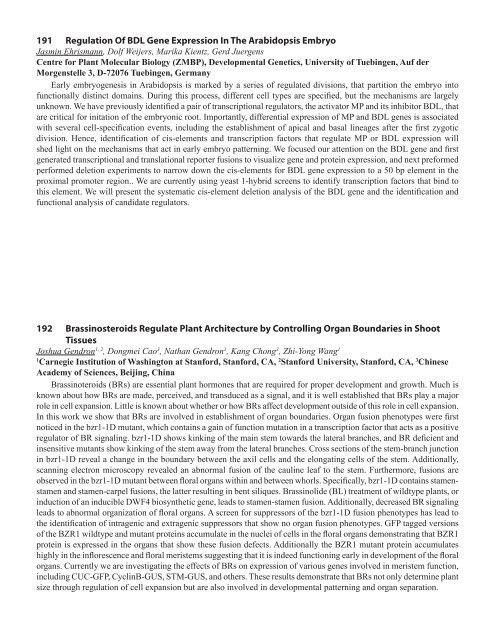75 Integrating Membrane Transport with Male Gametophyte ... - TAIR
75 Integrating Membrane Transport with Male Gametophyte ... - TAIR
75 Integrating Membrane Transport with Male Gametophyte ... - TAIR
Create successful ePaper yourself
Turn your PDF publications into a flip-book with our unique Google optimized e-Paper software.
191 Regulation Of BDL Gene Expression In The Arabidopsis Embryo<br />
Jasmin Ehrismann, Dolf Weijers, Marika Kientz, Gerd Juergens<br />
Centre for Plant Molecular Biology (ZMBP), Developmental Genetics, University of Tuebingen, Auf der<br />
Morgenstelle 3, D-72076 Tuebingen, Germany<br />
Early embryogenesis in Arabidopsis is marked by a series of regulated divisions, that partition the embryo into<br />
functionally distinct domains. During this process, different cell types are specified, but the mechanisms are largely<br />
unknown. We have previously identified a pair of transcriptional regulators, the activator MP and its inhibitor BDL, that<br />
are critical for initation of the embryonic root. Importantly, differential expression of MP and BDL genes is associated<br />
<strong>with</strong> several cell-specification events, including the establishment of apical and basal lineages after the first zygotic<br />
division. Hence, identification of cis-elements and transcription factors that regulate MP or BDL expression will<br />
shed light on the mechanisms that act in early embryo patterning. We focused our attention on the BDL gene and first<br />
generated transcriptional and translational reporter fusions to visualize gene and protein expression, and next preformed<br />
performed deletion experiments to narrow down the cis-elements for BDL gene expression to a 50 bp element in the<br />
proximal promoter region.. We are currently using yeast 1-hybrid screens to identify transcription factors that bind to<br />
this element. We will present the systematic cis-element deletion analysis of the BDL gene and the identification and<br />
functional analysis of candidate regulators.<br />
192 Brassinosteroids Regulate Plant Architecture by Controlling Organ Boundaries in Shoot<br />
Tissues<br />
Joshua Gendron 1, 2 , Dongmei Cao 3 , Nathan Gendron 1 , Kang Chong 3 , Zhi-Yong Wang 1<br />
1<br />
Carnegie Institution of Washington at Stanford, Stanford, CA, 2 Stanford University, Stanford, CA, 3 Chinese<br />
Academy of Sciences, Beijing, China<br />
Brassinoteroids (BRs) are essential plant hormones that are required for proper development and growth. Much is<br />
known about how BRs are made, perceived, and transduced as a signal, and it is well established that BRs play a major<br />
role in cell expansion. Little is known about whether or how BRs affect development outside of this role in cell expansion.<br />
In this work we show that BRs are involved in establishment of organ boundaries. Organ fusion phenotypes were first<br />
noticed in the bzr1-1D mutant, which contains a gain of function mutation in a transcription factor that acts as a positive<br />
regulator of BR signaling. bzr1-1D shows kinking of the main stem towards the lateral branches, and BR deficient and<br />
insensitive mutants show kinking of the stem away from the lateral branches. Cross sections of the stem-branch junction<br />
in bzr1-1D reveal a change in the boundary between the axil cells and the elongating cells of the stem. Additionally,<br />
scanning electron microscopy revealed an abnormal fusion of the cauline leaf to the stem. Furthermore, fusions are<br />
observed in the bzr1-1D mutant between floral organs <strong>with</strong>in and between whorls. Specifically, bzr1-1D contains stamenstamen<br />
and stamen-carpel fusions, the latter resulting in bent siliques. Brassinolide (BL) treatment of wildtype plants, or<br />
induction of an inducible DWF4 biosynthetic gene, leads to stamen-stamen fusion. Additionally, decreased BR signaling<br />
leads to abnormal organization of floral organs. A screen for suppressors of the bzr1-1D fusion phenotypes has lead to<br />
the identification of intragenic and extragenic suppressors that show no organ fusion phenotypes. GFP tagged versions<br />
of the BZR1 wildtype and mutant proteins accumulate in the nuclei of cells in the floral organs demonstrating that BZR1<br />
protein is expressed in the organs that show these fusion defects. Additionally the BZR1 mutant protein accumulates<br />
highly in the inflorescence and floral meristems suggesting that it is indeed functioning early in development of the floral<br />
organs. Currently we are investigating the effects of BRs on expression of various genes involved in meristem function,<br />
including CUC-GFP, CyclinB-GUS, STM-GUS, and others. These results demonstrate that BRs not only determine plant<br />
size through regulation of cell expansion but are also involved in developmental patterning and organ separation.





